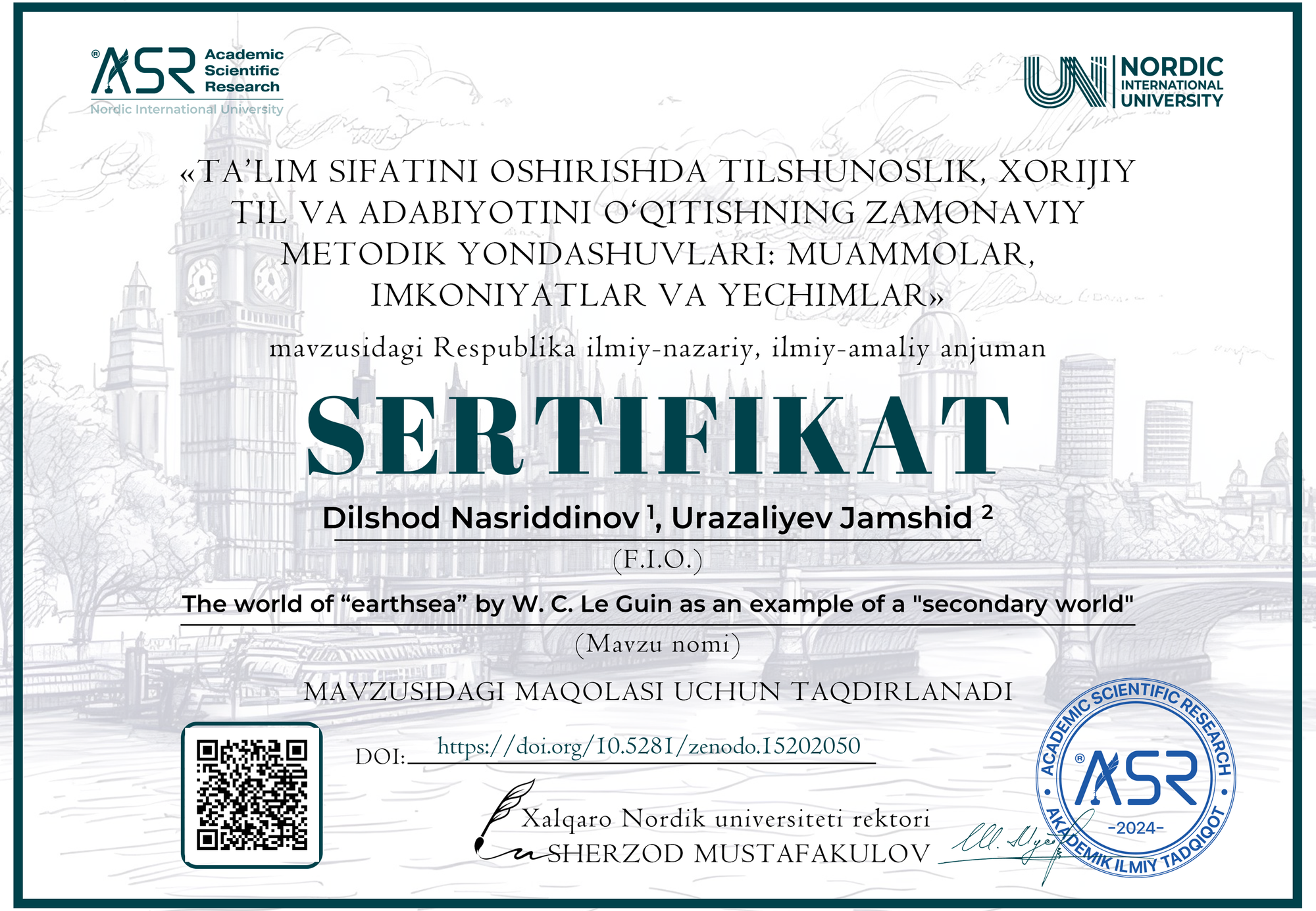Dilshod Nasriddinov 1, Urazaliyev Jamshid 2

DOI: https://doi.org/10.5281/zenodo.15202050
Zenodo community: https://zenodo.org/records/15202050
Nordic_press journal: https://research.nordicuniversity.org/index.php/nordic/article/view/2348
MAQOLANI YUKLAB OLISH
SERTIFIKATNI YUKLAB OLISH
REVIEW:
This article examines Ursula K. Le Guin’s "Earthsea" series, focusing on the concept of the "secondary world" in fantasy literature. The authors explore the meaning, origin, and development of this term within the fantasy genre. They analyze the ontological and mythological elements in the construction of Earthsea's geography, culture, and climate, highlighting the systematic nature of this fictional world.
The article begins by discussing the development of the fantasy genre, including its two main subgenres: high fantasy and low fantasy. High fantasy takes place in a world that is entirely separate from reality and follows its own set of laws, while low fantasy involves magical elements that exist within the real world. Drawing on J.R.R. Tolkien's essay "On Fairy-Stories," the article elaborates on his distinction between the "primary world" (the real world) and the "secondary world" (a fully imagined, separate universe).
The article emphasizes how Le Guin's "Earthsea" is an exemplary "secondary world." Through a detailed analysis of Earthsea’s map, the authors explain how Le Guin’s world-building is integral to the series. It is not merely a geographic feature; the world itself is part of the foundation upon which the entire Earthsea Cycle was built. The creation of Earthsea, initially beginning with a couple of short stories, evolved into a rich, expansive archipelago, with Le Guin carefully constructing its climate, culture, languages, and mythologies.
Earthsea is depicted as a society with a technological level akin to the early Iron Age, where bronze is used in places where iron is scarce, and wood and other workable metals are employed for making weapons. The climate of Earthsea is temperate, mirroring the mid-latitudes of the northern hemisphere, with the southern regions exhibiting subtropical features. The archipelago follows the same seasonal cycle as Earth, with varying climates across the islands. The central islands of Earthsea, such as Gont and Havnor, experience warm summers and cold winters, while other areas have distinct geographic and cultural characteristics.
The inhabitants of Earthsea speak various dialects, but the dominant language is Ardic, derived from an ancient and sacred language known as the True Speech, in which all creatures and objects are named by their true names. The people of Earthsea are diverse, with the majority of central islanders possessing "copper-brown" skin, while the southern and eastern reaches are inhabited by dark-skinned people with straight black hair. Additionally, dragons, an intelligent and powerful species, exist in Earthsea, some of which are wise, while others are more monstrous and destructive.
The world of Earthsea is entirely detached from the "primary world" and follows its own unique laws. It has its own culture, language, ethnic groups, and cosmogonic myth, making it a fully realized "secondary world" in fantasy literature. The Earthsea Cycle, through its detailed ontological and mythological systems, presents one of the most fully developed secondary worlds in the genre.
Conclusion:
This article provides an insightful and detailed analysis of "Earthsea" as an exemplary "secondary world." Le Guin’s world-building, with its rich and intricate systems of geography, language, and culture, serves as a model for understanding the depth of imagination required to create a convincing and immersive fictional universe. The study highlights the uniqueness of Earthsea and Le Guin's contribution to the fantasy genre, presenting her work as a prime example of how secondary worlds can be fully realized in literature. The article is a valuable resource for anyone studying fantasy literature and the art of world-building in fictional settings.



